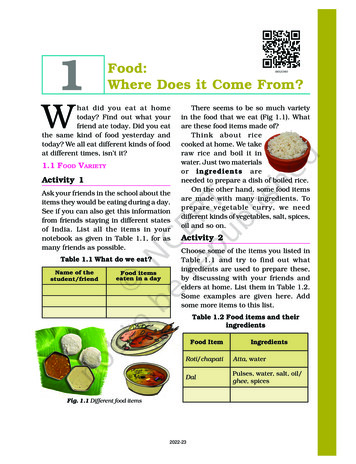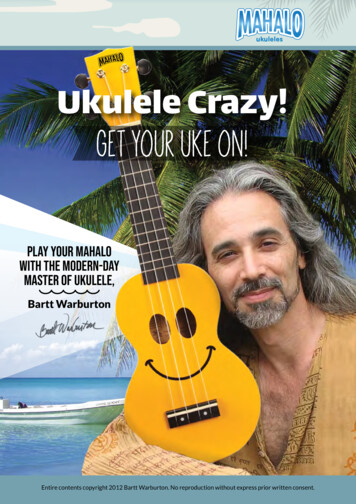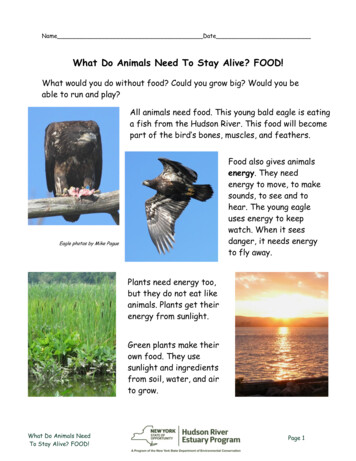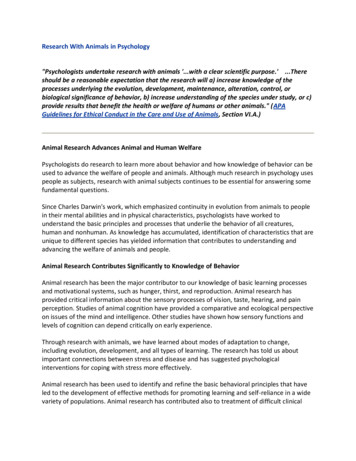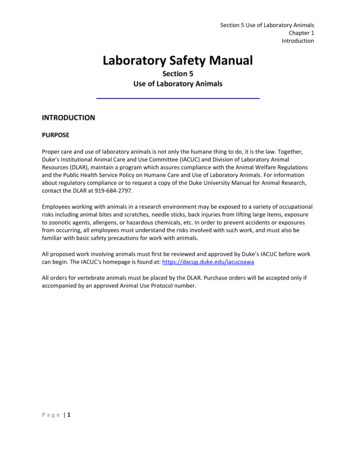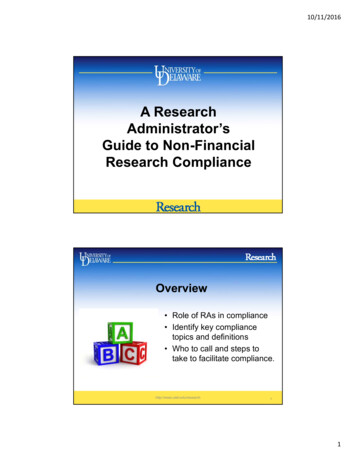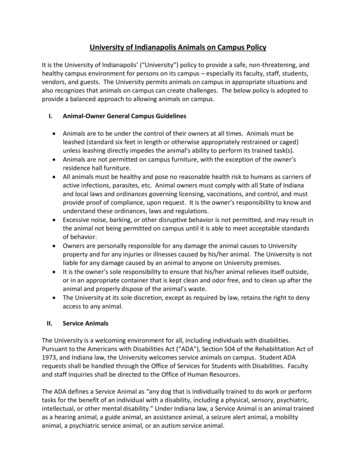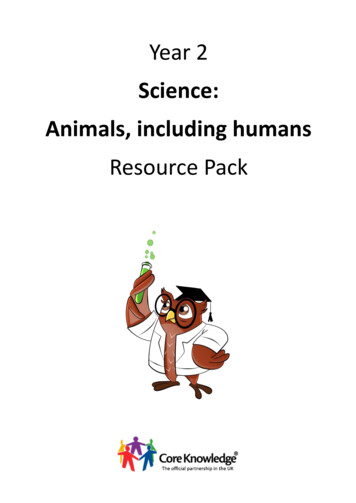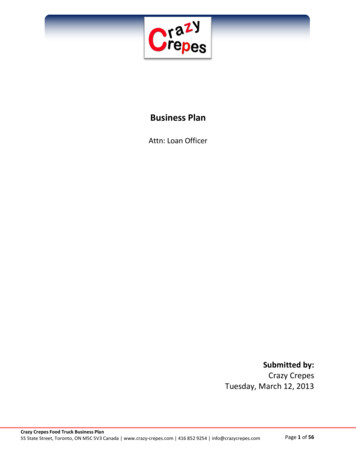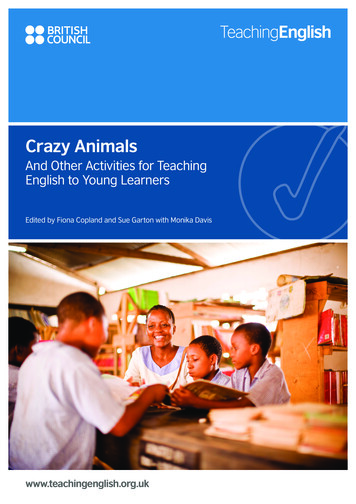
Transcription
Crazy AnimalsAnd Other Activities for TeachingEnglish to Young LearnersEdited by Fiona Copland and Sue Garton with Monika Daviswww.teachingenglish.org.uk
ISBN 978-0-86355-693-7 British Council 2012 Brand and Design / B36910 Spring GardensLondon SW1A 2BN, UKwww.britishcouncil.org
TeachingEnglish Young Learners Activity BookIntroductionContentsIntroduction03Activity 26: Numbers and words58Activities08Activity 27: Outburst60Activity 1: Act out08Activity 28: Put on your hats!62Activity 2: Acting songs10Activity 29: Scrambled rhymes64Activity 3: Alphabet and sound recognition12Activity 30: Something about me66Activity 4: At the zoo14Activity 31: Sound stories68Activity 5: Birthdays16Activity 32: Storybook predictions70Activity 6: Brown bear, brown bear18Activity 33: Swap the dot72Activity 7: Calendars20Activity 34: Take the yellow one!74Activity 8: Change places, please22Activity 35: Taste the fruit!76Activity 9: Crazy animals24Activity 36: The house seller78Activity 10: Creative chairs26Activity 37: The noun tree80Activity 11: Plants and seeds28Activity 38: The snake game82Activity 12: Fairy tale chains30Activity 39: Throwing a ball84Activity 13: Fly the airplane, pilot!32Activity 40: Toothpick game86Activity 14: Global presentations34Activity 41: Tourist role play88Activity 15: Hammer battles36Activity 42: Traffic lights90Activity 16: Handkerchief tag38Activity 43: Vocabulary chart92Activity 17: Hidden words40Activity 44: Vocabulary challenge94Activity 18: I have it in my name42Activity 45: Walking the words96Activity 19: Information translation44Activity 46: We are different98Activity 20: Label me!46Activity 21: Story-telling –Little Red Riding HoodActivity 47: Where is the poisoned apple?10048Activity 48: Wordle prediction102Activity 22: Chain game50Activity 49: Words competition104Activity 23: Memory game52Activity 50: Writing basket for early finishers 106Activity 24: Messy closet54Index grid108Activity 25: My season’s book56Contributors110 British Council 20121
TeachingEnglish Young Learners Activity BookIntroduction2 British Council 2012
TeachingEnglish Young Learners Activity BookIntroductionIntroductionThere are many books of activities forteaching English in the primary classroom,but this book is different. It is differentbecause all the activities have been triedand tested by the very people who aregoing to use them, teachers like you. Theseteachers work in the most diverse contextsand conditions, sometimes with large classes,sometimes with very small groups, sometimeswith every type of resource you could wishfor, sometimes with only a board to supporttheir teaching. However, they share a desireto help their students to learn English in anenjoyable way. We imagine you too share thisdesire and that is why you have picked thisbook. We hope you find the activities useful,engaging and fun too, and enjoy using themin your class.original activity in order either to provide veryclear guidance, or to make it more appropriatefor teachers everywhere. We are extremelygrateful to all those who sent in activities,whether they are included here or not, andto teachers who gave us their opinion onthem, such as teachers of young learnersat the JALT 2011 conference in Tokyo.The ActivitiesHow the book was bornFor each activity, we give the ages of thechildren it is suitable for and the time it takes.Both of these should be taken as guides only.Very often, the English level of the children ismore important than their age to the success ofthe activity. In addition, the timing of the activitydepends on the size of the class or how quickthe children are to respond. You will always bethe best judge of whether an activity is suitablefor your class and how long it is likely to take.The book is the direct result of a year-longproject called ‘Investigating Global Practicesin Teaching English to Young Learners’ ctices-teaching-english-young-learners).A number of primary school teachers whoresponded to the survey in this study told usabout the kinds of activities they used in classto motivate their learners. We felt that theseideas deserved to be shared with primaryteachers all over the world, and so the ideafor this book was born.Each activity has a section called Alternativesin which we give different ideas for using theactivity. These are either related activities thatwere sent in by other teachers, or our own ideas.There is also a section called No Resources?,which suggests ways of doing the activity evenif you do not have access to the resourcesneeded, such as computers, flashcards or evensufficient coloured paper for all the children.We have also included a Preparation sectionso you will know how long it will take you toprepare for each activity.We contacted over 1,000 teachers who had lefttheir e-mail addresses on the survey site andasked them to send us their favourite activitiesfor teaching English to young learners. Fromthe many we received, we selected the 50 thatwe felt were the most original and creative, butalso the most practical for the greatest numberof teachers. In most cases, we have edited theWe know that many teachers work with largeclasses and so we have indicated if the activitiesare suitable for this context. We take a largeclass to be 30 children. Even where activitiesare indicated as not being suitable for largeclasses, it is worth looking at the Alternativessection as often we suggest an approach forusing the same activity with large classes. British Council 20123
TeachingEnglish Young Learners Activity BookIntroductionFinding activitiesThe activities are simply presented inalphabetical order. We have also developeda table which you can use to find activitiesquickly. The table gives the list of activities andthen some useful information about them, forexample, if they are suitable for large classes or ifresources are required (other than a board, boardpen/chalk, paper and pencils/pens, which webelieve are readily available in most classrooms).However, these are only guidelines and youmight find that an activity we recommend forvery young learners (4–6/7) is suitable in yourcontext for junior learners (7–11) or even olderlearners (12 ). Timings, as we say above, are veryapproximate. In the table we indicate if they aregenerally short (5–20 minutes), medium length(20–40 minutes) or long (over 40 minutes).Again, please use your own judgement todecide how long activities will take.Some considerations when usingthe activitiesLanguage in the young learner classroomFor many children, their only source ofexposure to English will be you, the teacher.For this reason, it is advisable to take allpossible opportunities to speak English in theclassroom. However, this does not mean thatyour English has to be perfect or that you haveto speak English all the time. Indeed, switchingbetween different languages is common inmany everyday contexts for many people, andthe classroom is no different in this regard. Inthis book, we have suggested where using thechildren’s first language might be effective, butthis does not mean you should avoid it at othertimes. You are the best judge of how to supportyour children’s learning in the classroom.4There are lots of different ways that you canuse English, however. You can use English toorganise the activities in this book, to controlthe class while they do them and to talk to thechildren on a one-to-one basis. Many of theactivities in the book have steps that involvethe children in quiet tasks, such as cuttingand pasting, drawing, colouring and so on,that do not explicitly practise new structuresor vocabulary. While children are engaged inthese, you can chat to them more informally.It is not necessary to use complex language;simple, encouraging comments are effectiveand might include things like, ‘Cut the shapescarefully. You can use all the colours you want.How are you getting on? Have you nearlyfinished? What colour are you going to usenext?’ and so on. Slattery and Willis (2001) isan excellent source of English expressions touse in the primary classroom.But what about the children’s language use?We cannot expect children to use English allthe time. It is not only unnatural; it can alsodamage children’s confidence. Of course,children can be encouraged to use English inwhole class activities and also while workingwith their peers in pairs and groups. However,if children use their first language in theseactivities, it should not be seen as a problem,particularly if the input is in English or somepart of the output requires children to useEnglish. At some stage of the activity, childrenwill be involved with English, and this is whatis important for young learners.Teachers play a critical role in creating anenvironment in which children feel happy tryingout their English skills. As well as encouragingchildren and praising their efforts, teachers needto have confidence in their own English speakingskills, whatever their level. If children see theirteachers speaking English with enjoyment andenthusiasm, not worrying about making mistakesor knowing every word, then they have a verypositive model for using English themselves. Wehope the activities in this book play their part inproviding the kind of fun and engaging activitiesthat can motivate children to use English in class. British Council 2012
TeachingEnglish Young Learners Activity BookIntroductionWhole class work, group work, pair workThere are activities in this book for the wholeclass and for individual, group and pair work.Whole class activities involve all the learnersand are important for developing a positiveclassroom approach to learning English,good relationships between learners and theopportunity for students to learn from both theteacher and from each other. Many of the wholeclass activities involve students becomingphysically involved in the learning experience,by holding up cards, for example, or by workingin teams. The teachers who suggested thesewhole class activities certainly do not viewwhole class work as a passive experience!Many of the activities in this book involvechildren working in groups or pairs. Someteachers are reluctant to try these approaches,especially if their classes are large. Theseteachers argue that they cannot monitor whatall the children are doing, that the children willspeak their first language, or that the class willget out of control. Therefore, teachers oftenturn activities that are meant to be done ingroups or pairs into whole class activities.There are a number of reasons why we wouldencourage you to use pair and group workwhere the activity states this mode oforganisation, even if you have never tried itbefore. First, if activities are done as a wholeclass, the children may not be directly involvedin participating and can become bored anddistracted. This is especially true in largeclasses. On the other hand, if children areworking in pairs and groups, they will all havethe opportunity to use English and to beengaged in the activity. Second, pair and groupwork can also help children to develop otherskills such as listening to others, co-operatingand reaching a consensus. These skills areuseful to children no matter how good theirEnglish is! Third, pair and group work canprovide a change of pace in a lesson andso revitalise the class atmosphere. British Council 2012Children can be kept on task in pair and groupwork in a number of ways. For example, onechild can be nominated a group monitor, orgroup ‘captain’ and it is this child’s responsibilityto ensure that the task is completed.Alternatively, you can have a points or rewardssystem (see below) and award points to groupsthat stay on task and complete the activity.Working in groups and pairs inevitablyincreases the noise level of a class, even wherethe children are closely monitored. If you workin a context where noise is not tolerated, or isassociated with lack of discipline or work, youcan try to explain to the head teacher, andteachers who are affected by the noise, whatyou are doing and why (or show him/her/themthis introduction). You can also warn teachersin advance when the children will be doingpair or group work to demonstrate that youunderstand the inconvenience but also toshow that these activities are planned into yourteaching and part of your pedagogic practices.Rewarding childrenSome of the activities in this book suggestgiving rewards to children who ‘win’. Someteachers take sweets or other prizes into theclassroom to give to children who completean activity first (see below for a discussion ofcompetition), behave particularly well, do anactivity successfully and so on. However, youneed to consider whether it is appropriate oracceptable in your context to use rewards. Evenif it is, you need to consider the effect of rewardson the children. If the same children constantlyget the rewards (or do not get them), it can bede-motivating and could have negative effectson the classroom dynamics. Rewarding as manychildren as possible is one way of dealing withthis: children can be rewarded for effort as wellas success, for example.5
TeachingEnglish Young Learners Activity BookIntroductionA system that we have observed in primaryclasses involves dividing the class into smallgroups (4–6 children per group), and usinga reward point system. The groups can bechanged regularly, once a month for example,and different strategies can be used to formthe groups, with the teachers either choosingthe groups or making a random selection, orchildren choosing their own groups. Childrenthen earn points for their group, rather thanrewards for themselves. Points are given forperforming well in activities, for good behaviourin class, for completing homework, answeringquestions in class, and classroom management,such as finding material quickly. This rewardsystem encourages collective class responsibility.CompetitionSome of the activities encourage bothindividual and group competition, with a‘winner’ at the end. While a certain amountof competition can be healthy, the samepotential difficulties exist as with using rewards.Competition can push some children to performbetter, but it can be de-motivating for others.We suggest a limited use of competition inactivities and a preference for collectiveresponsibility whereby a child wins for theirgroup, rather than for themselves.6Concluding CommentsWe have had great fun putting this booktogether and learnt a lot of new approachesand ideas for teaching English to younglearners. We hope that in using the book youwill also have fun and learn, and that yourchildren will too!We would love to hear from you about yourexperiences in using these activities and anychanges you make to meet your children’sneeds or that of the context in which you work.Send your thoughts and ideas to lss activities@aston.ac.ukReferencesEnglish for Primary Teachers (Resource Booksfor Teachers) by Mary Slattery and Jane Willis(24 May 2001) Oxford OUP British Council 2012
TeachingEnglish Young Learners Activity BookIntroduction British Council 20127
TeachingEnglish Young Learners Activity BookActivitiesActivity 1: Act outEliana Fernandez Malla – Dominican RepublicAge: All ages15–30 minutes Large classes? NoMixed level? YesMaterials: Cards illustrating action verbs (e.g. dance, eat, walk, etc.), sand clock or timer.Organisation: Pair work, group work, whole class.Aim: To revise and practise the present continuous tense.Description: This is a simple but fun way for children to practise a grammar point througha guessing game with mime.Preparation: Make flashcards with a picture of a different action on each one. Actions couldinclude, run, jump, cry, laugh, run, sleep, cough, stretch, brush, clap, smile, walk, sit, stand, write,read, listen, speak, wash, wriggle, sneeze, blink, wink, turn.Procedure1. Show the picture cards one at a time to the whole class. Elicit the verbs illustrated andpractise the pronunciation of each one. Ask the children to mime the action.2. Divide the class into groups of two or three. Each group decides who will mime and whowill guess. Decide which group will go first and say that each group will have two minutesto guess as many actions as they can.3. Bring the first group to the front of the class. Ask the child who will mime to stand so all thechildren in the class can see. Give the child the first card. They mime the action on the card.The group has to guess what the mime is by calling out, for example, ‘you are running/you’rerunning’. If they guess correctly, they take the card and the teacher gives the child a newcard. If they don’t know, they say ‘next one’, the card goes back to the bottom of the pileand the child continues to the next card.4. After two minutes, the group counts the number of cards it has collected and records thenumber on the board. The cards are given back to the teacher, and the second groupcomes to the front to guess.5. The winning group is the one with most points recorded on the board.NotesYou could make correct pronunciation a condition of getting the point, or you could awardan extra point for it.8 British Council 2012
TeachingEnglish Young Learners Activity BookActivitiesAlternatives Each group takes it in turns to send one person to the front to mime one verb at a time. Each group has its own set of cards and works at the same time, with members taking it inturns to pick up a card and act it out. If you have a large class, one member of each groupcan observe another group. They get points for their group if they notice any errors, forexample if the group gives itself a point it should not have. Depending on the level of the children, you could also award extra points if they can tell youthe past form of the verb, and/or the past participle. The game would work with other tenses too, but you should try and make the context asnatural as possible.For example:a. to practise the past continuous, the children can call out their guesses after the childat the front has finished miming – ‘you were walking’.b. To practise the past simple, the child at front can mime a series of actions while the groupwrites them down. After the two minutes, the group calls out the sequence: ‘you walked,then you sat down, then you read a book’. Rather than miming the action, the children can draw the action on the board. The children inthe group guess in the usual way. To make it more challenging, write the verb on the flashcardsrather than drawing a picture. Children then have to read and show they understand what theverb means by drawing it.No resources?If you do not have the resources to make cards with illustrations, you can simply write the verbon a piece of paper. British Council 20129
TeachingEnglish Young Learners Activity BookActivitiesActivity 2: Acting songsNatalia Paliashvili – GeorgiaAge: 4 –715 minutesLarge classes? YesMixed level? YesMaterials: Song words and recordings of the songs, equipment to play the song, flashcards,pictures and objects to illustrate the words from the song.Organisation: Whole class.Aim: To develop stress and rhythm through song.Description: This activity involves children learning the words and doing actions to songs.Traditional songs are ideal as they are melodic, repetitive and easy to memorise. Look forsongs such as London’s Burning, Old Macdonald had a Farm, London Bridge is Falling Down,Oranges and Lemons, Twinkle Twinkle Little Star etc. See, for example, . The activity below is for London Bridge is Falling Down.Preparation: You will need to download the song and the words you wish to use.Procedure1. Pre-teach the main words ‘bridge, fall down/build up, lady, sticks, stones’. Use a mixtureof actions, mime, objects and pictures to make the words memorable.2. Play or sing the song to the children two or three times while they just listen. Use actions,mimes and gestures to illustrate the song as you sing it. Encourage the children to join inmiming and singing.3. Ask the children to repeat any words/phrases they have understood. Write these wordson the board.4. Play or sing the song and do the actions again, but this time stop after each line and askthe children to repeat both the words and actions.5. Play or sing the whole song again, with the children singing along and doing the actions.6. Repeat stage 5 but this time give individual children different parts to act out.10 British Council 2012
TeachingEnglish Young Learners Activity BookActivitiesAlternatives Songs can also be used to practise day-to-day vocabulary and language structures.For example, this is the way (I brush my teeth) repeats the present simple tense with anumber of daily routines. Likewise, Ten Little Aeroplanes presents counting up to ten andback again. These songs, with activities and animations, can be found on the British Councilwebsite learnenglishkids.britishcouncil.org/en/songs/ This site also has great songsto practise stress and rhythm: Chocolate Cake is one of our favourites. Songs can be exploited in lots of different ways. Here is an idea from Ornella Granatiero (Italy)called Go on Singing. In this activity, a song from the children’s course book is used, but youcould use any song. The materials are the same as for the activity on the previous page:1. Play or sing the song two or three times while the children listen in silence, follow the wordsin their books or look at the flashcards.2. Play or sing the song again two or three times, this time with the children singing andmiming actions.3. Once the children can sing most of the song, play or sing it again, but stop after a fewlines and ask one of the children or a group of children to continue the song. After oneor two lines, start playing it again. Repeat this, asking different children to continue until theend of the song.No resources?If you do not have equipment to play songs, you can sing them yourself. If you do not have accessto the internet to download song words, you can make up simple songs yourself. The importantthing is that they are memorable for the children with lots of repetition. You could ask the childrento clap or beat the rhythm or to mime actions. Do not worry if you are not a good singer, you canchant instead. British Council 201211
TeachingEnglish Young Learners Activity BookActivitiesActivity 3: Alphabet and sound recognitionWendy Weiss Simon – IsraelAge: All ages10 minutes per lessonLarge classes? YesMixed level? YesMaterials: Flashcards with letters of the alphabet, use both small letters and capitals.Organisation: Individual work, pair work or group work.Aim: To develop identification of letters and knowledge of sounds.Description: This activity helps students to learn the order of the letters of the alphabetand their sounds by working with flashcards in a variety of ways.Preparation: A set of cards of the letters of the alphabet for each individual, pair or group.The teacher will also need a set of big letter flashcards, suitable for putting on the board.Procedure1. Give one set of letter cards to each student, pair or group of students and ask themto spread the letters out on the top of their desks, leaving a space at the bottom.2. Ask the students to tell you the order of the letters in the alphabet and start putting up yourflashcards in the correct order on the board, or write the letters in order. At the same time,the children rearrange the cards on their desk into the correct order.3. Once all the children have their cards in the right order, the teacher calls out a letterand the children hold up the card with the letter on it.NotesRemember to collect up all the cards at the end of the activity, making sure they are notin order, so that they are ready to use again next lesson.12 British Council 2012
TeachingEnglish Young Learners Activity BookActivitiesAlternatives In the second part of the activity, instead of calling out letters, call out sounds and childrenhold up the corresponding letter(s). You can also call out sounds made up of more than one letter (th, sh, ch). Give the children words or short phrases to spell out using the cards on their desk. Remember,do not ask children to spell words which use the same letter twice, such as all, as the childrenonly have one card with each letter! Ask children to spell words that they have recently learnt using the cards. If you give each carda number value (for example, a 1 and z 5) children can gain points for the words they spell,like in Scrabble. In pairs or groups, children can play a dominos game. Divide two sets of letters amongst thechildren. The first child makes a word from the letters they have and lays them down on thedesk. The next child then tries to make another word, using their own letters and those alreadyon the desk. The child with the fewest letters left is the winner.No resources?All of the above activities can be carried out by writing the alphabet on the board and simplyasking the children to call out the relevant letters. Alternatively, children can be asked to cometo the board to indicate the correct letter(s) or write out the word/phrase.bl British Council 2012o n get13
TeachingEnglish Young Learners Activity BookActivitiesActivity 4: At the zooRaisa Dukaļska – LatviaAge: 5 –105–20 minutesLarge classes? YesMixed level? YesMaterials: Pictures of animals and dice.Organisation: Whole class.Aim: To practise or revise animal vocabulary and to produce simple descriptions.Description: Pictures of animals from the zoo are put on the board and numbered 1– 6.Children take it in turns to throw a dice. The number thrown corresponds to an animal onthe board, and the child must make a sentence about the animal.Preparation: You will need pictures of zoo animals to put on the board, ensuring they are bigenough for the whole class to see. Clipart is a good source, or you can draw the animals yourself.Procedure1. Before playing the game, revise the numbers 1– 6, the names of some animals, and someadjectives to describe the animals.2. Put the pictures of the animals on the board and give each animal a number from 1– 6.1.2.3.4.5.6.3. Ask for a volunteer to throw the dice. When the dice lands on a number, the child must saywhich animal corresponds to that number. The teacher (or the child) writes the name of theanimal on the board under the picture:It is a lion14 British Council 2012
TeachingEnglish Young Learners Activity BookActivities4. Another volunteer throws the dice. If thenumber lands on the same number, thevolunteer must say something about theanimal (for example, ‘it is big’). The teachercan write this on the board. If the numberis different, the volunteer names a differentanimal. The text might look somethinglike this:5. The game continues until all the animalsare named and have been described.The number of sentences you write foreach animal depends on the level ofthe children.It is a lion. It is big. It is golden.It likes sleeping and eating.It is a .6. Once all the texts are on the board, erasekey vocabulary to create a gap fill. Ask forvolunteers to read out the texts and fillin the gaps.It is .It isIt likes and .Alternatives This game can be played in groups but you will need more pictures and more dice. You could also add animal sounds as these tend to be different in different languages! As the descriptions of the animals build up, you can ask the children to read out or rememberall the descriptions given so far before adding another sentence. For example, ‘It is a lion.It is big. It is golden. It likes sleeping and.’. For older children, choose a different category such as pop or music stars.No resources?You can write the names of the animals on the board, or you could draw them. You could askconfident children to come to the front to mime being the animals. You could also ask childrento respond to cues, such as, ‘jump like a monkey’, ‘roar like a lion’, ‘snap like a crocodile’If you have no dice, you can write numbers 1– 6 ondifferent pieces of paper, which the children can pull outof a box when it is their turn to shake the dice and makea sentence. British Council 201215
TeachingEnglish Young Learners Activity BookActivitiesActivity 5: BirthdaysDonatella Bergamaschi – ItalyAge: 4–1010–15 minutesLarge classes? YesMixed level? YesMaterials: A birthday hat, a birthday badge or sticker with ‘I’m 11’ (or whatever age) on it,a fabric or card birthday cake with fabric or card candles.Organisation: Whole class.Aim: To practise stress and intonation, and language chunks.Description: This activity introduces a routine that can be used at the start of the lessonwhen it is one of the children’s birthdays. The presents involved are imaginary, so encouragethe children to think creatively.Preparation: You will need to either find or make the badge, cake and hat.ProcedureTiming1. Ask the child whose birthday it is to come to the front of the class.Ask ‘How old are you?’ and give the child the badge or sticker withtheir age on it to wear for the duration of the class. All the children singHappy Birthday to youHappy Birthday to youHappy Birthday dear xxxxHappy Birthday to you.2. Ask the birthday child to ‘blow out’ the candles on the cake and put the hat on.3. The birthday child stands at the front of the class. Ask the other children‘who has a present for X’? The children who want to give a ‘present’ putup their hands and take it in turns to come up to the front.4. The two children repeat the following dialoguePresent giver: Hello. I’ve got a present for you.Birthday child: What is it?Present giver: It’s a Here you are.Birthday child: Thank you very much.5. Repeat until all the children who want to give a ‘present’ have hadtheir turn.16 British Council 2012
TeachingEnglish Young Learners Activity BookActivitiesAlternatives If you are short of time, the children can write their presents on pieces of paper, which theygive to the birthd
your children's learning in the classroom. There are lots of different ways that you can use English, however. You can use English to organise the activities in this book, to control the class while they do them and to talk to the children on a one-to-one basis. Many of the activities in the book have steps that involve

